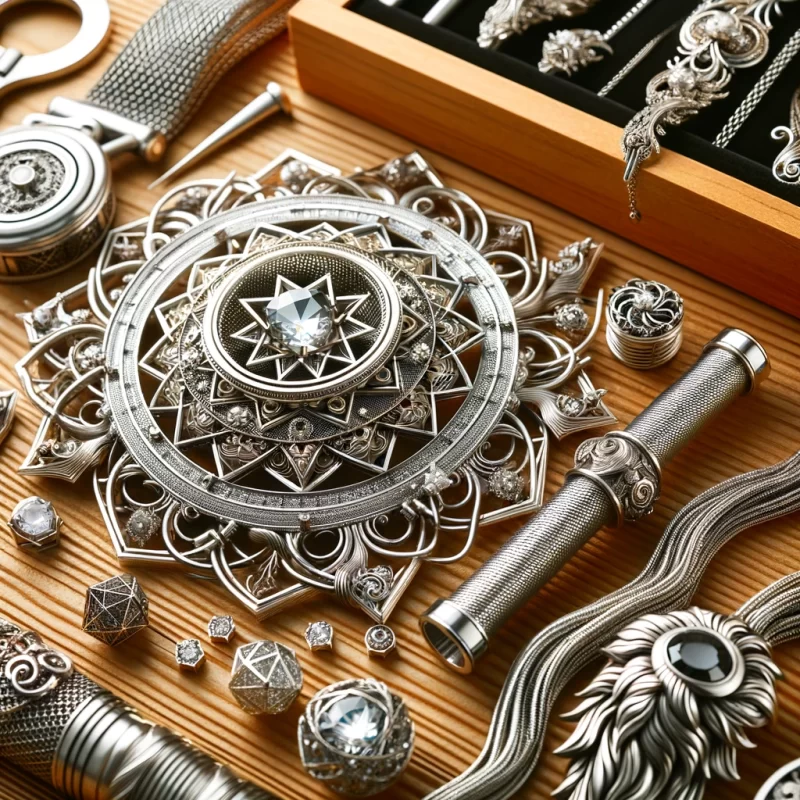
Table of Content
Ever wondered what the future of wedding bands looks like? Let me take you on a journey through the world of carbon fiber rings, a trend that’s not just emerging but firmly establishing itself as a staple in modern wedding ceremonies. This isn’t just about jewelry; it’s about the revolution in the way we think about and choose our symbols of love and commitment.
First off, let’s get the basics down. Carbon fiber, for those of you not in the know, is a material known for its incredible strength and lightweight properties. It’s been used in high-tech applications from race cars to aerospace engineering. But here’s the kicker: this space-age material is now making waves in the world of wedding bands, and for good reasons.
The Lightweight Champion of Wedding Bands
One of the first things you’ll notice when you slip a carbon fiber ring onto your finger is the sheer lightness of it. It’s so light, in fact, you might even forget you’re wearing it. Now, compare that to the traditional gold or platinum band that feels like a small dumbbell on your finger, and you’ll understand why many are making the switch.
Durability That’s Hard to Beat
Durability is another hallmark of carbon fiber rings. These bands can take a beating and come out looking just as sleek and polished as the day you bought them. They’re resistant to scratches and can withstand the rough and tumble of everyday life. For anyone who’s ever dinged their gold band by merely clapping their hands, this is a game-changer.
Hypoallergenic Properties
Another point for carbon fiber rings is their hypoallergenic nature. Unlike some metal bands that can cause allergic reactions or discolor your skin, carbon fiber is as neutral as Switzerland. It’s the perfect choice for those with sensitive skin or allergies to metals like nickel.
The Style Factor
But let’s not forget about style. Carbon fiber rings offer a sleek, modern look that’s quite different from the traditional band. They speak to a sense of individuality and a break from the norm. Plus, the material allows for a range of textures and finishes, from glossy to matte, giving you the opportunity to truly personalize your symbol of love.
Why They’re the Future
So, why am I so convinced that carbon fiber rings are the future of wedding bands? It boils down to a combination of their practical benefits and their unique aesthetic appeal. They represent a shift in how we view wedding bands—not just as symbols of love but as pieces of advanced engineering and design that can withstand the test of time.
Moreover, as we move towards more sustainable and ethical choices in all aspects of our lives, carbon fiber rings stand out. They’re a symbol of modern values, marrying the technology of tomorrow with the traditions of today.
A Personal Touch
Choosing a wedding band is deeply personal, and for my partner and me, the decision to go with carbon fiber was a nod to our shared values of innovation, durability, and style. It felt like a fresh way to express our commitment, in a form that resonates with our lives today and the future we’re building together.
In conclusion, as we embrace modern materials and technologies, carbon fiber rings emerge not just as an alternative, but as a new standard in wedding jewelry. Their appeal lies not just in their physical properties, but in what they represent: a commitment that’s ready to endure, evolve, and move forward, just like the love it symbolizes.
Have you ever thought about the material of your wedding band? Traditionally, we lean towards gold, silver, or platinum. But let me toss a new contender into the ring – carbon fiber. Yes, you heard that right. Carbon fiber, the same material that’s revving up the auto and aerospace industries, is now setting the jewelry world ablaze. And here’s why it’s not just a fleeting trend but the future of wedding bands.
Carbon fiber rings? Sounds pretty high-tech, doesn’t it? That’s because it is. This material, known for its strength, durability, and lightweight nature, is making a grand entrance into the world of matrimonial symbolism. And boy, does it make an entrance.
First off, let’s talk about the weight, or rather, the lack thereof. Carbon fiber is light as a feather compared to traditional metals. This means you can say goodbye to that heavy feeling on your finger and hello to comfort you barely notice, except for its striking appearance, of course.
Then there’s the durability aspect. These rings can take a beating and come out looking just as sleek and polished as day one. Drop it, scratch it, run it over with your family sedan – it’s all the same to a carbon fiber ring. This resilience makes it an ideal symbol for the enduring nature of love and commitment.
Now, onto design and customization. The flexibility of carbon fiber allows for a plethora of design options, from sleek and modern to intricate and unique. Want something that stands out? Carbon fiber rings can be crafted with various textures, finishes, and even inlaid with other materials like gold, diamonds, or wood for that personalized touch.
But what really sets carbon fiber apart in the love game is its hypoallergenic property. This is a godsend for those with sensitive skin who might react to metals like nickel. With carbon fiber, your skin gets the gentle touch it deserves.
Affordability is another major plus. While prices can range based on design and craftsmanship, carbon fiber rings generally offer a budget-friendly alternative to precious metals. This means you can save those extra bucks for the honeymoon or, you know, a fancy espresso machine that you’ll use every morning together.
And let’s not forget about the environmental and ethical considerations. Unlike metals that might be mined under less-than-ideal conditions, carbon fiber offers a conflict-free alternative. It’s a choice that feels as good on your conscience as it does on your finger.
Before you think it’s all rainbows and unicorns, there are a couple of things to consider. Resizing can be a challenge, and the color options are primarily limited to shades of black and gray. However, for many, these are small concessions for a ring that is as enduring and unique as their love.
In summary, carbon fiber rings represent not just a shift in material preference but a broader change in how we think about wedding bands. They embody modernity, resilience, and a touch of individuality, all wrapped up in a stylish, lightweight package. So, if you’re planning to tie the knot and are in search of a ring that breaks the mold, consider the sleek, durable, and futuristic charm of carbon fiber. It’s not just a symbol of your love; it’s a statement.
As we delve deeper into the allure of carbon fiber jewelry, particularly wedding bands, it’s essential to understand how this material aligns with contemporary values and lifestyles. The modern consumer, especially those in their love’s initial or enduring chapters, seeks more than just aesthetics in jewelry; they desire a symbol that reflects their values, including sustainability, individuality, and resilience.
Carbon fiber, with its origins in industries requiring supreme durability and lightweight properties, offers a metaphorical parallel to modern relationships. These bands are not just accessories; they symbolize a partnership that is strong, adaptable, and forward-looking. The narrative around carbon fiber rings extends beyond their physical attributes, tapping into stories of innovation, technology, and a departure from traditional constraints.
Moreover, the individuality offered by carbon fiber cannot be overstated. In an era where personal expression and uniqueness are highly valued, carbon fiber rings stand out. They offer a sleek, contemporary look that resonates with those who see themselves as trendsetters or outside the conventional norms. This is a generation that values distinctiveness and the ability to customize their symbols of love, making carbon fiber an attractive option.
The environmental aspect also plays a significant role in the appeal of carbon fiber rings. As awareness and concern for ethical sourcing and sustainability grow, the demand for alternatives to traditional jewelry materials increases. Carbon fiber offers a compelling option for those looking to make eco-friendlier choices. Its production process and the materials used offer a less environmentally impactful alternative, aligning with the values of a more conscientious consumer base.
In addition to these advantages, the practicality of carbon fiber in everyday life makes it an excellent choice for wedding bands. Its resistance to scratches and damage, coupled with its lightweight nature, ensures that the ring remains a comfortable, lasting symbol of love. For those leading active lifestyles or with professions that put jewelry at risk, carbon fiber offers peace of mind without sacrificing style.
However, embracing carbon fiber does not mean forsaking tradition entirely. On the contrary, it reflects a broadening of the definition of what’s valuable and meaningful in symbolizing commitment. It’s about offering more choices to cater to diverse tastes and values.
In wrapping up, the shift towards carbon fiber wedding bands signifies more than just a change in jewelry trends. It represents a broader movement towards innovation, individuality, sustainability, and practicality in expressing love and commitment. As we look to the future, carbon fiber stands as a testament to the evolving nature of matrimonial symbols, promising a blend of tradition and modernity that resonates with the contemporary consumer.
Continuing our exploration into the innovative world of carbon fiber jewelry, let’s consider its broader implications in the fashion industry and beyond. The fascination with carbon fiber extends beyond its physical characteristics; it’s a reflection of a society increasingly intertwined with technology and innovation. As we move forward, the integration of such materials in everyday objects, including jewelry, speaks volumes about our shifting priorities and interests.
Carbon fiber jewelry, especially wedding bands, stands at the intersection of tradition and modernity. This convergence is not just a trend but a movement towards redefining what we hold dear and how we express our commitments. It’s about marrying the timeless with the futuristic, creating symbols of love that resonate with the tech-savvy, environmentally conscious, and style-forward individuals of today.
The adoption of carbon fiber in jewelry also mirrors broader trends in consumer behavior. There’s a growing appetite for products that not only look good but also tell a story of sustainability, innovation, and resilience. In this context, carbon fiber rings are more than just decorative items; they are emblematic of a new era of consumer products that align with the values of the next generation.
This shift also encourages the jewelry industry to innovate and think creatively about materials and designs. As carbon fiber becomes more popular, it pushes designers to explore other non-traditional materials and techniques, driving forward a wave of innovation that could redefine what jewelry can be. This exploration is not confined to aesthetics alone but extends to the ethical and environmental impact of production processes and materials.
In embracing carbon fiber and similar materials, the fashion industry is also making a statement about the importance of adaptability and forward-thinking. It’s a recognition that to stay relevant and appealing to a changing audience, the industry must evolve, embracing the new while respecting the old.
Finally, the rise of carbon fiber jewelry is a testament to the power of choice. In offering alternatives to traditional metals, the industry is acknowledging and catering to a diverse range of preferences and needs. This inclusivity and openness to innovation are what will propel the jewelry industry into the future, with carbon fiber leading the charge as a material that encapsulates the essence of modern love and commitment.
As we consider the journey of carbon fiber from the labs to our jewelry boxes, it’s clear that its story is interwoven with broader narratives about progress, innovation, and the reimagining of tradition. The future of fashion and jewelry lies in this delicate balance, where the new does not overshadow the old but rather complements it, creating a rich tapestry of choices that reflect the complexity and diversity of modern life.
Exploring the technological advancements shaping the future of fashion reveals a fascinating intersection of innovation, creativity, and sustainability. Here’s how these advancements are revolutionizing the industry:
Generative AI is transforming fashion design, production, and marketing by working alongside human designers to create unique, trend-informed products. This technology optimizes production floors and diversifies marketing strategies, marking 2024 as the year for meaningful AI implementation within fashion processes.
3D Printing and Prototyping are enabling designers to create prototypes rapidly, reducing the costs associated with physical sampling and pushing the boundaries of personalization and design flexibility.
Fit-Tech aims to solve the sizing inconsistency challenge in the fashion industry by using a combination of machine learning, AI, AR mirrors, and body scanners to create personalized sizing solutions. This technology could significantly reduce the number of returns and enhance customer satisfaction.
Smart Fabrics and Novel Materials introduce functionalities like temperature adaptation, moisture-wicking, and even health monitoring into everyday clothing, expanding the role of garments beyond mere aesthetics.
Digital Factories leverage IoT, RFID, and motion sensors for real-time monitoring and control, leading to increased productivity, quality control, and sustainability. The concept of digital twins mirrors physical factory processes in real time, enabling simulation, prediction, and proactive decision-making.
Blockchain Technology enhances supply chain transparency and accountability, allowing consumers to trace the lifecycle of their garments from creation to consumption, thereby ensuring authenticity and amplifying the narrative behind each piece.
Wearable Technology and the Internet of Things (IoT) integrate digital capabilities into apparel, affecting how we experience our surroundings, interact with others, and monitor our health. This includes smart clothing and accessories that connect to the internet, sharing data and improving the wearer’s quality of life.
Rapid Data Analysis tools enable quick adaptation by using large amounts of data to support business adjustments. These tools help save money, eliminate waste, and maximize customer satisfaction by providing real-time feedback on production.
Mobile Commerce is becoming increasingly prevalent, with apps for shopping, selling, and even renting clothes making fashion more accessible and promoting sustainability.
Virtual and Augmented Reality (VR/AR) are merging the physical and online retail worlds, allowing customers to virtually try on clothes, enhancing the shopping experience and potentially increasing sales.
These technological advancements are not just reshaping the way we design, produce, and consume fashion; they’re also pushing the industry toward a more sustainable, efficient, and customer-centered future.
Continuing our exploration of technological advancements in fashion, it’s essential to consider the cultural and social implications these technologies have on the industry. As fashion technology advances, so does the potential for a more inclusive and diverse industry landscape. This not only opens up new avenues for creativity and expression but also challenges traditional norms and practices within fashion.
Inclusivity and Diversity Through Technology
Fashion technology’s rise contributes significantly to inclusivity and diversity within the industry. For instance, AI and VR can democratize fashion by providing more personalized experiences for consumers of all body types, abilities, and backgrounds. This personalization extends from product design and fit to the shopping experience, ensuring that fashion is accessible to a broader audience.
Moreover, the use of blockchain for traceability introduces a level of transparency that can empower consumers to make more ethical choices. By providing a clear view of the supply chain, consumers can support brands that prioritize sustainable practices and fair labor conditions, promoting a more responsible fashion industry.
The Ethical Dimension
As technology reshapes the fashion landscape, it’s crucial to navigate the ethical dimensions of these advancements. The sustainability of new materials, the energy consumption of digital factories, and the data privacy implications of AI and IoT devices are pivotal concerns. The industry must address these issues head-on, ensuring that technological progress does not come at the expense of environmental degradation or consumer privacy.
Looking Ahead: The Future of Fashion Technology
Looking forward, the intersection of fashion and technology holds endless possibilities. From the development of entirely new materials that are both sustainable and high-performing to the complete digitization of the fashion value chain, the future is bright. However, this future also demands a responsible approach to technology adoption, emphasizing sustainability, ethics, and inclusivity.
As we stand on the brink of this new era in fashion, it’s clear that technology will be a driving force in shaping a more inclusive, sustainable, and innovative industry. But it’s equally important that this journey is undertaken with a commitment to ethical practices and a focus on the well-being of both people and the planet.
By embracing the potential of technology while remaining mindful of its challenges, the fashion industry can embark on a transformative path that leads to a future where fashion is not only about what we wear but also about the values we stand for.
Conclusion
The fusion of fashion and technology is more than a trend; it’s a revolution that’s set to redefine the industry. As we navigate this exciting terrain, the innovation potential is limitless. Yet, the true measure of this evolution will be how it contributes to a more sustainable, inclusive, and ethical fashion ecosystem. The journey ahead is promising, filled with opportunities to redefine elegance and purpose in the digital age.
This brings us to the end of our exploration of technological advancements in fashion. The integration of AI, 3D printing, VR/AR, IoT, and novel materials into the fabric of the fashion industry illustrates a compelling future where technology and creativity converge to create a more inclusive, sustainable, and fascinating world of fashion.



